Abstract
Human filarial infections afflict over 150 million persons worldwide and are major causes of morbidity in many developing countries. Onchocerca volvulus infection is a leading preventable cause of blindness, while bancroftian and brugian filariasis may produce lymphatic obstruction of the genitalia and extremities (elephantiasis). Definitive diagnosis of these helminthic infections currently depends on demonstration of microfilariae in host tissues, i.e., the skin in the case of O. volvulus and the bloodstream in the cases of Wuchereria bancrofti and Brugia malayi. Many investigations are now directed at developing specific and sensitive serum antigen assays that will allow diagnosis of active infection (i.e., presence of adult-stage parasites) in the absence of detectable microfilariae. With respect to the immunology of these parasitic infections, efforts are being directed at elucidating the role of T- and B-cell responses in the development of pathologic lesions and resistance to reinfection. These data as well as molecular biologic approaches to identify and study filarial molecules which are immunogenic are discussed. Finally, since treatment of filariases at present depends on antiparasitic drugs, the clinical indications and dosages of diethylcarbamazine and ivermectin are summarized.
Full text
PDF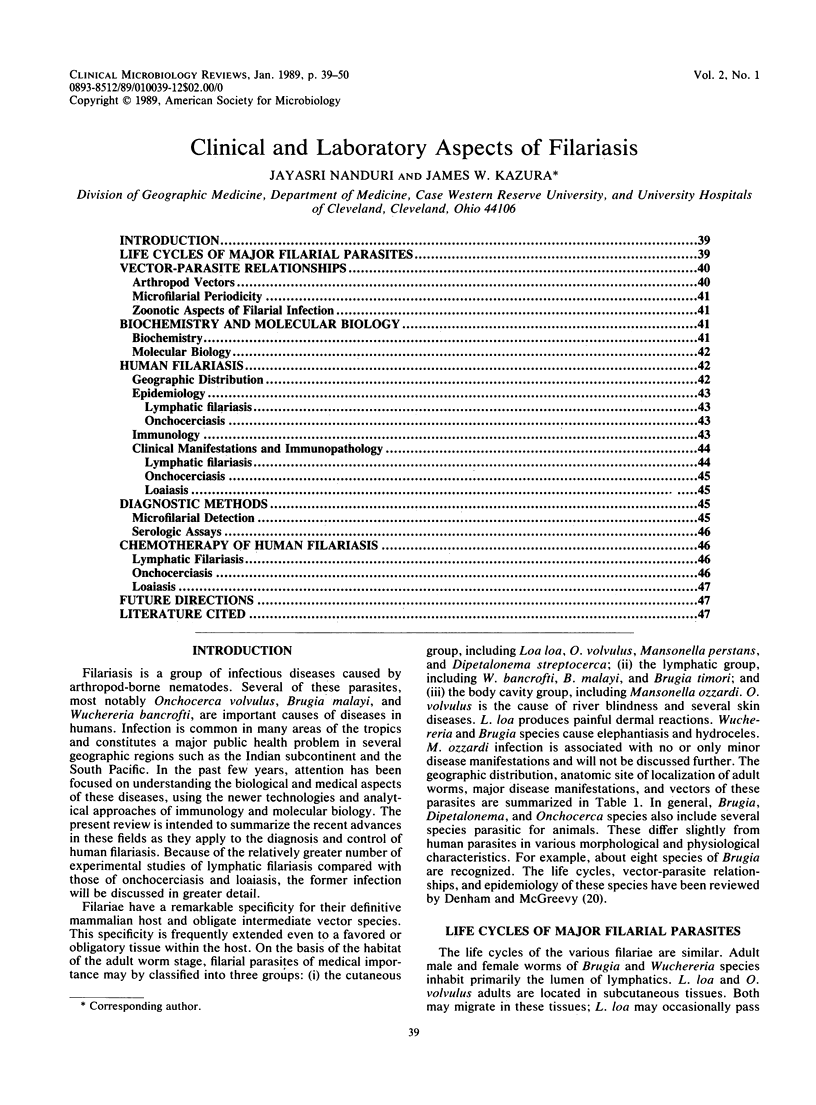
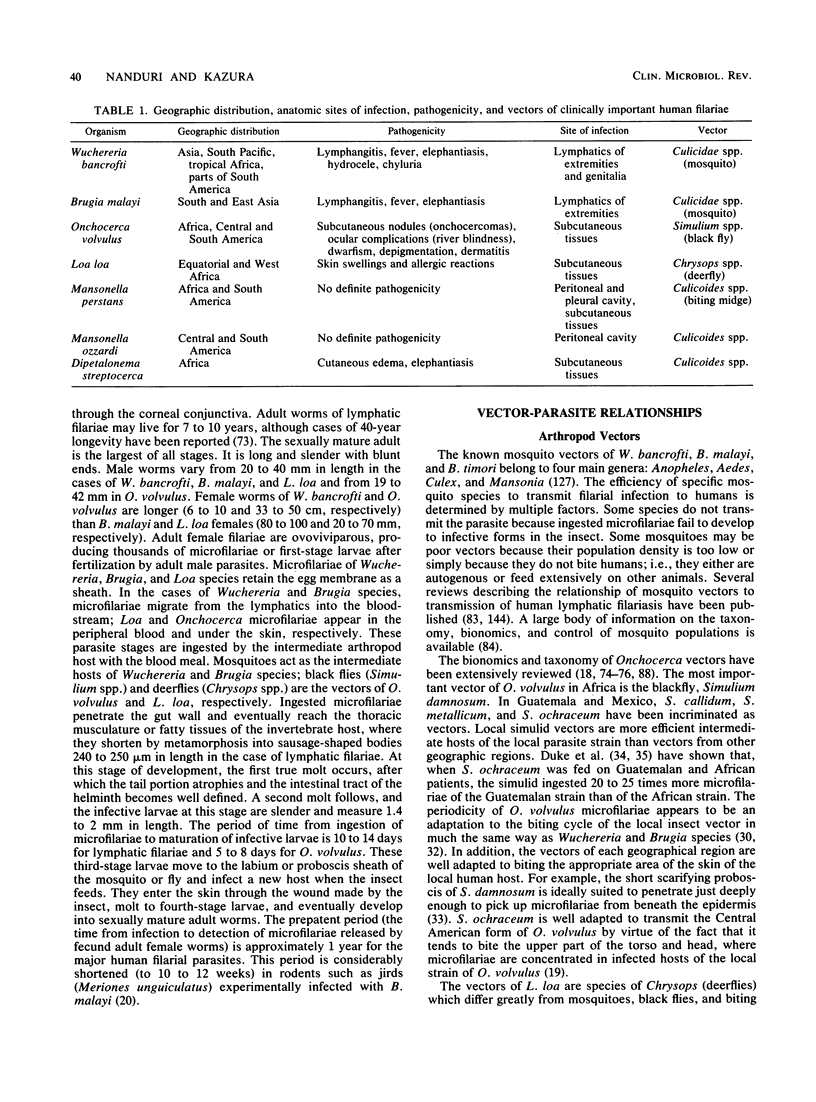
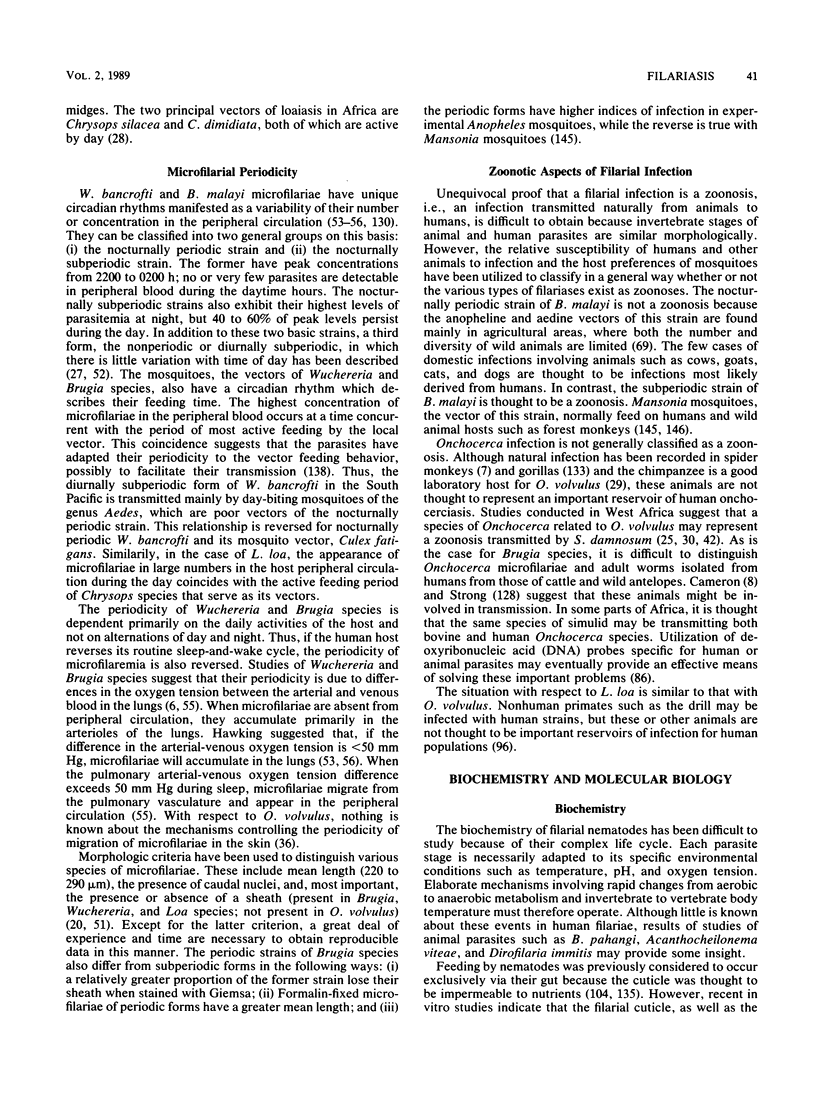
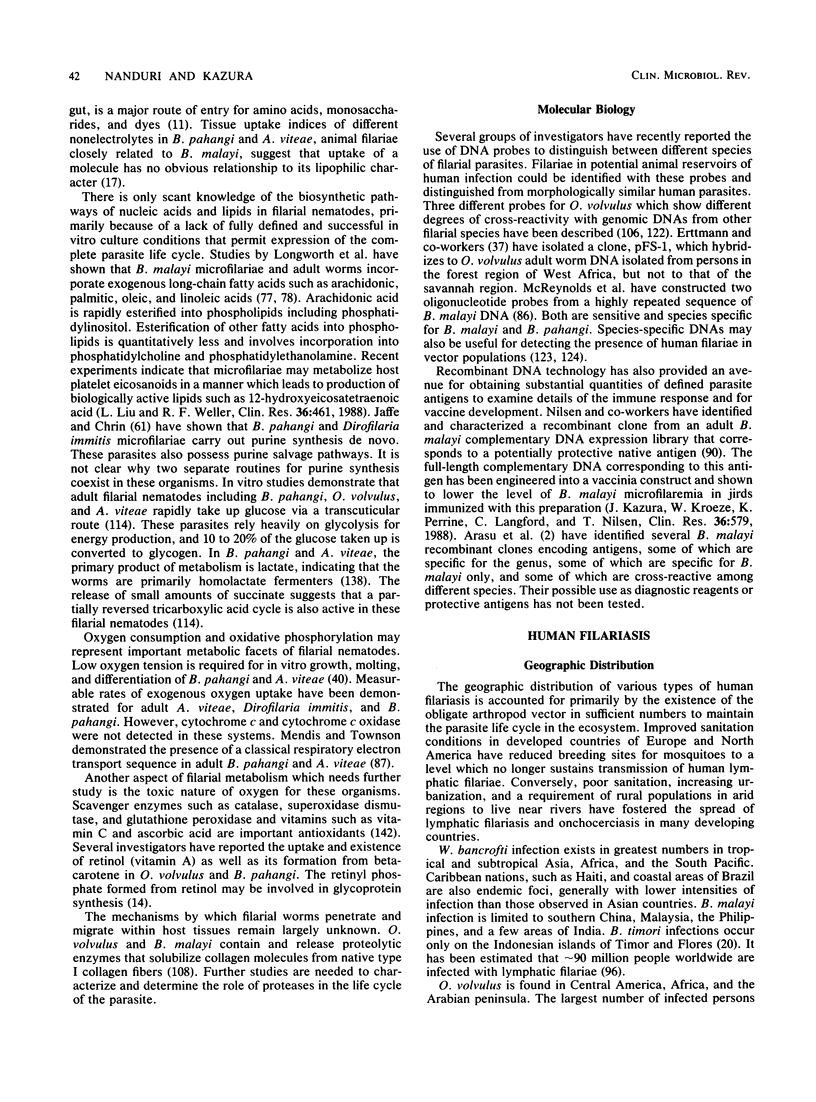
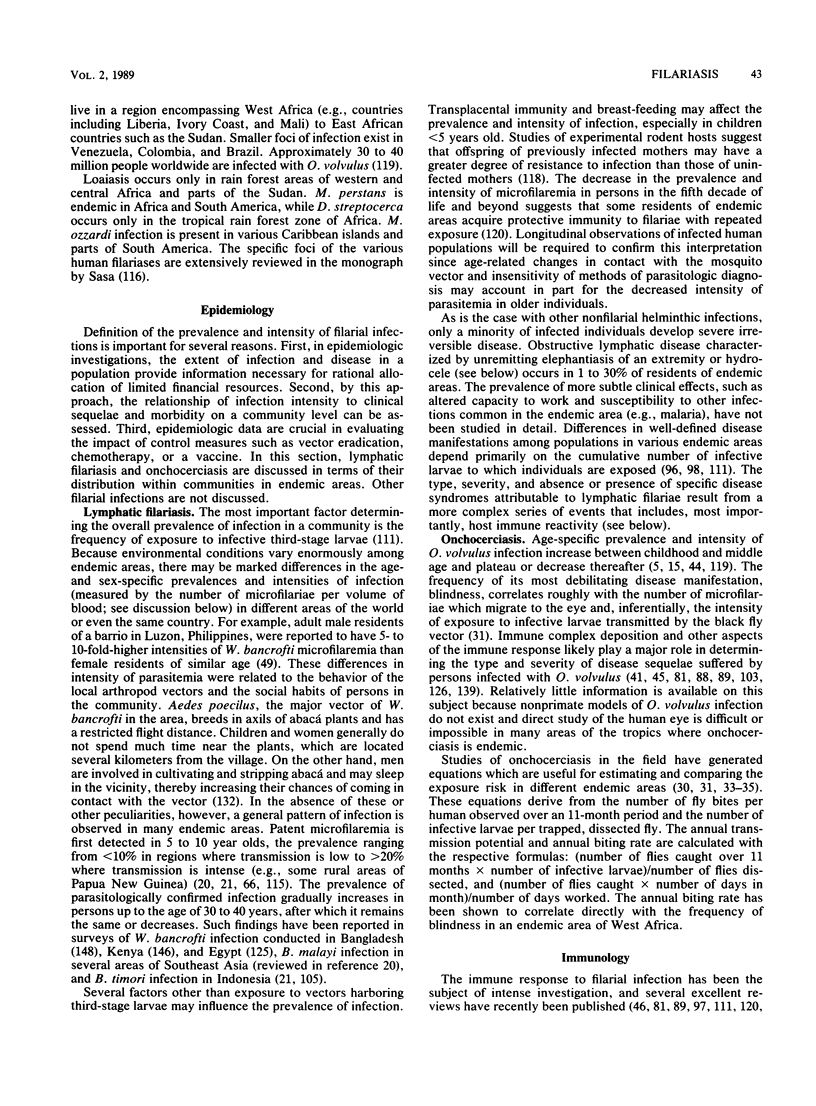
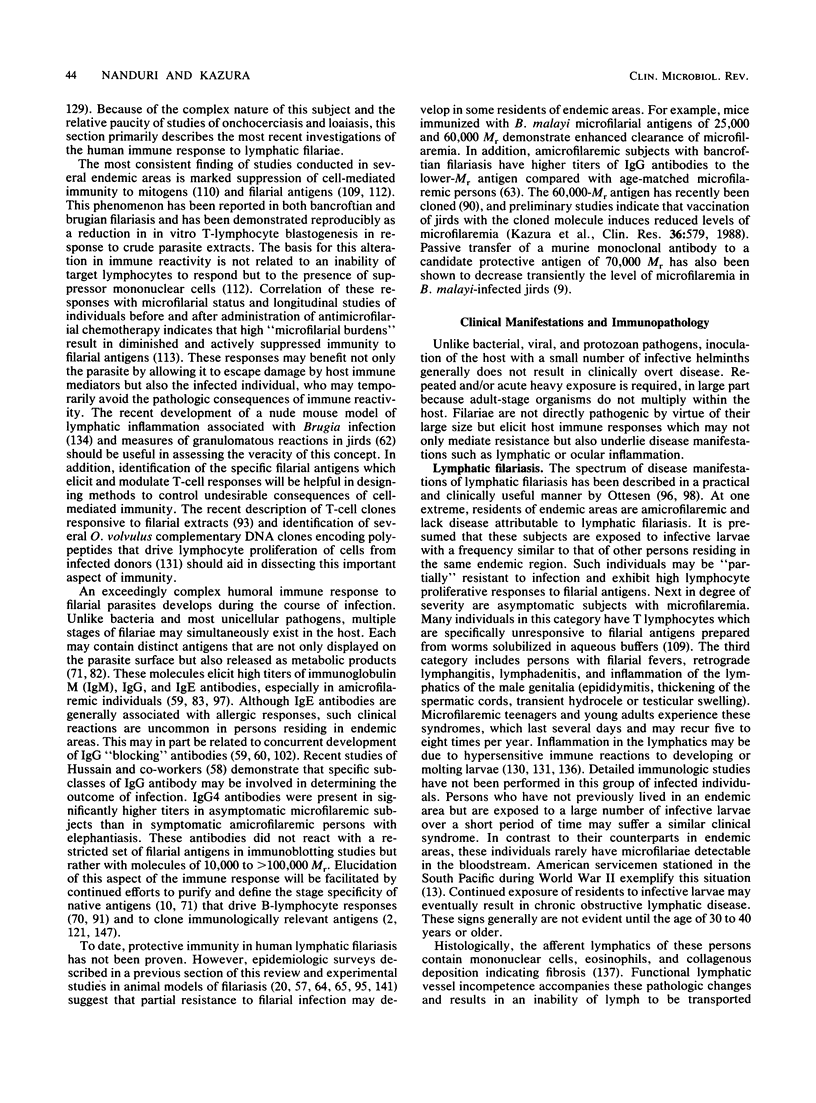
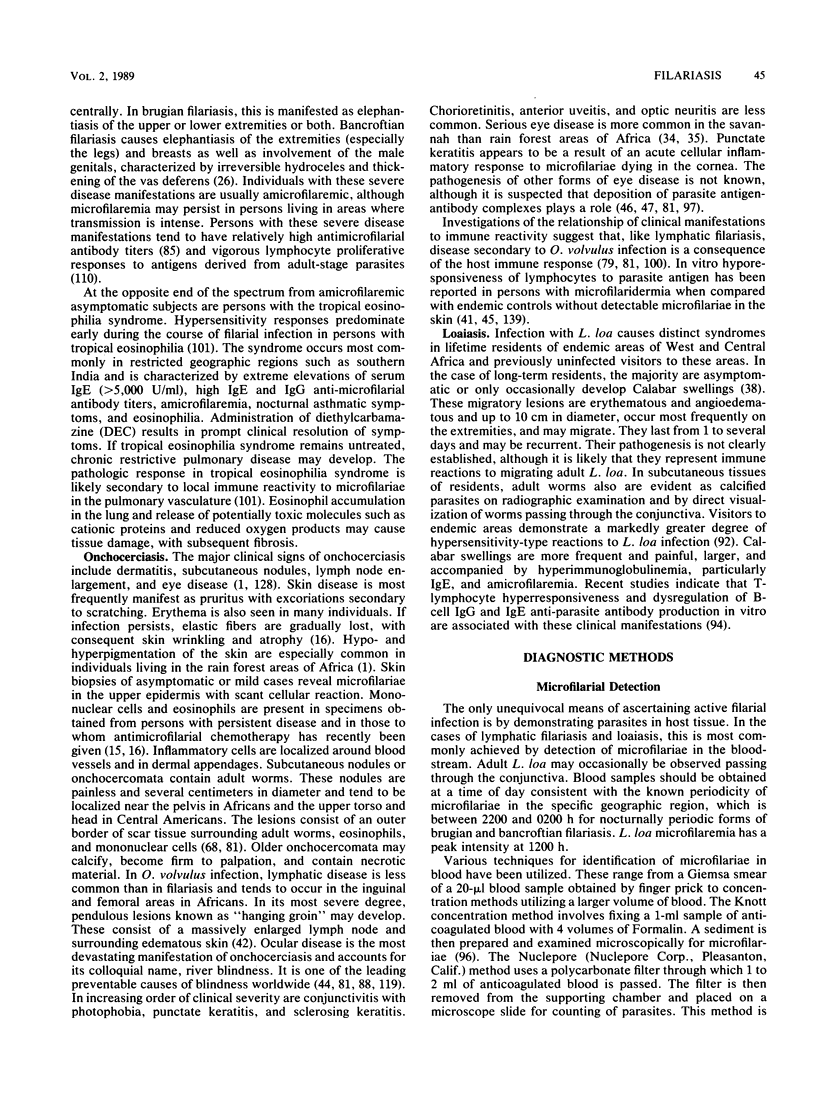
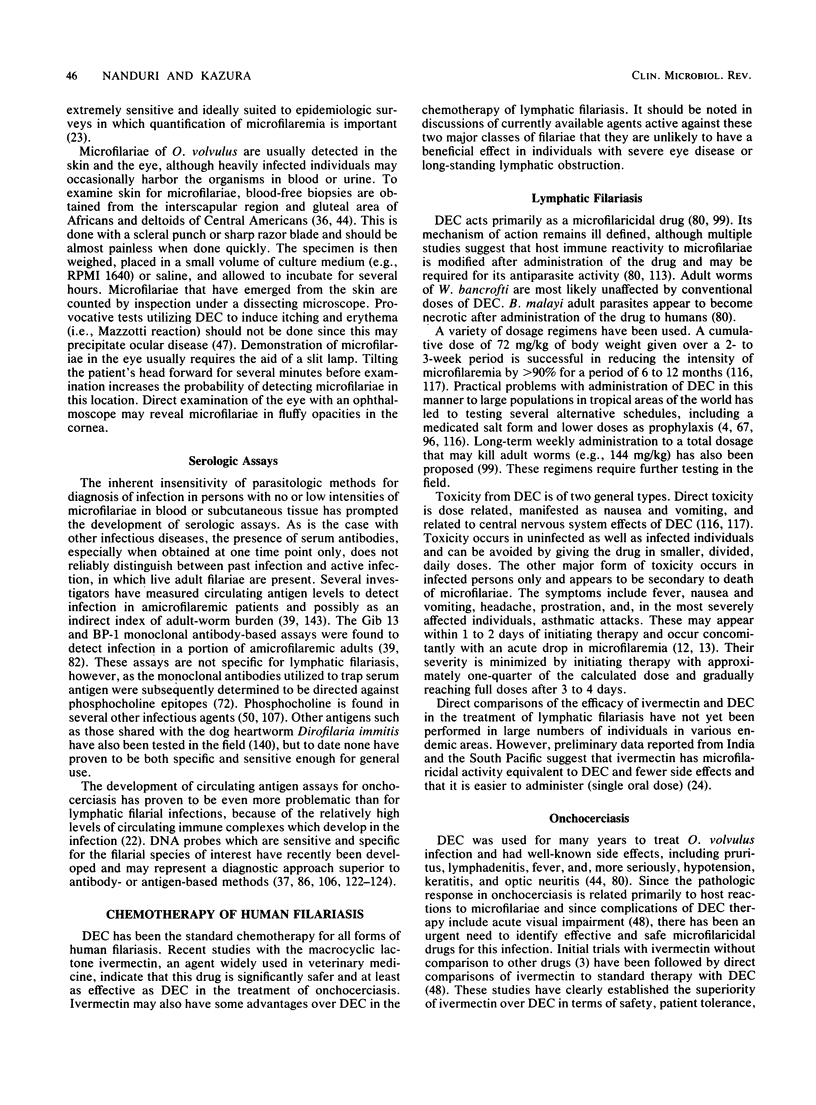
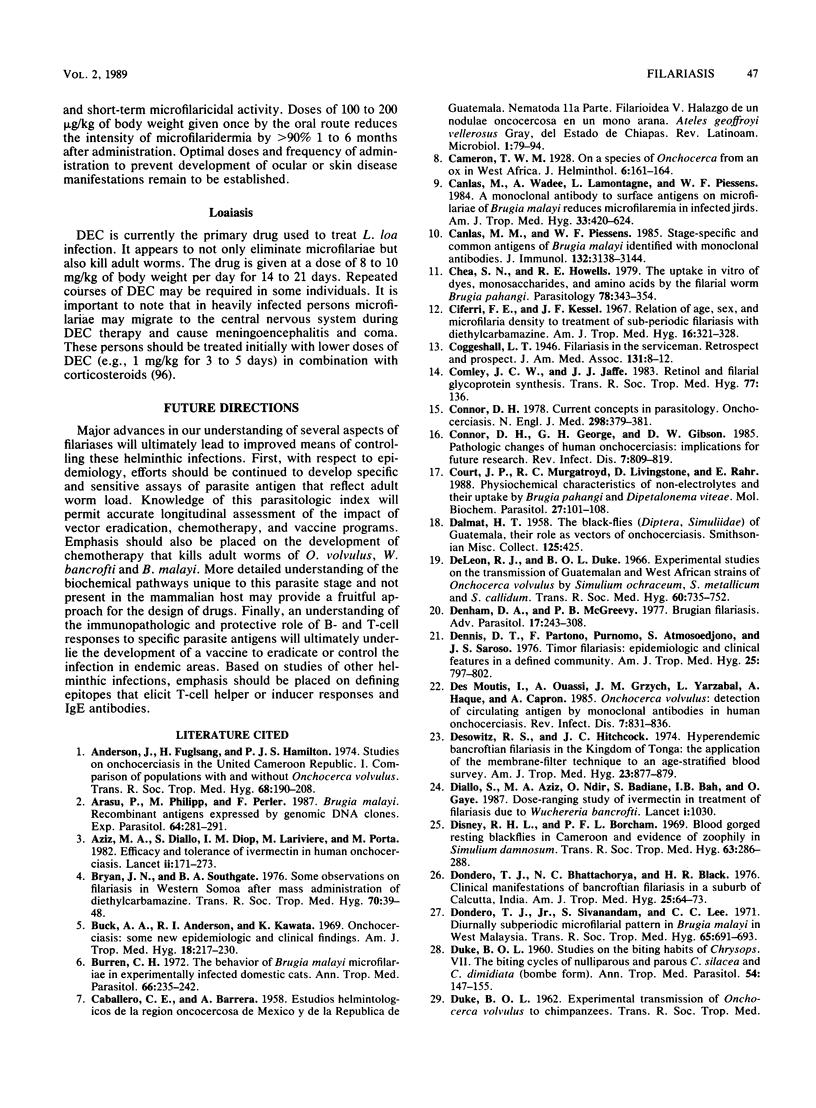
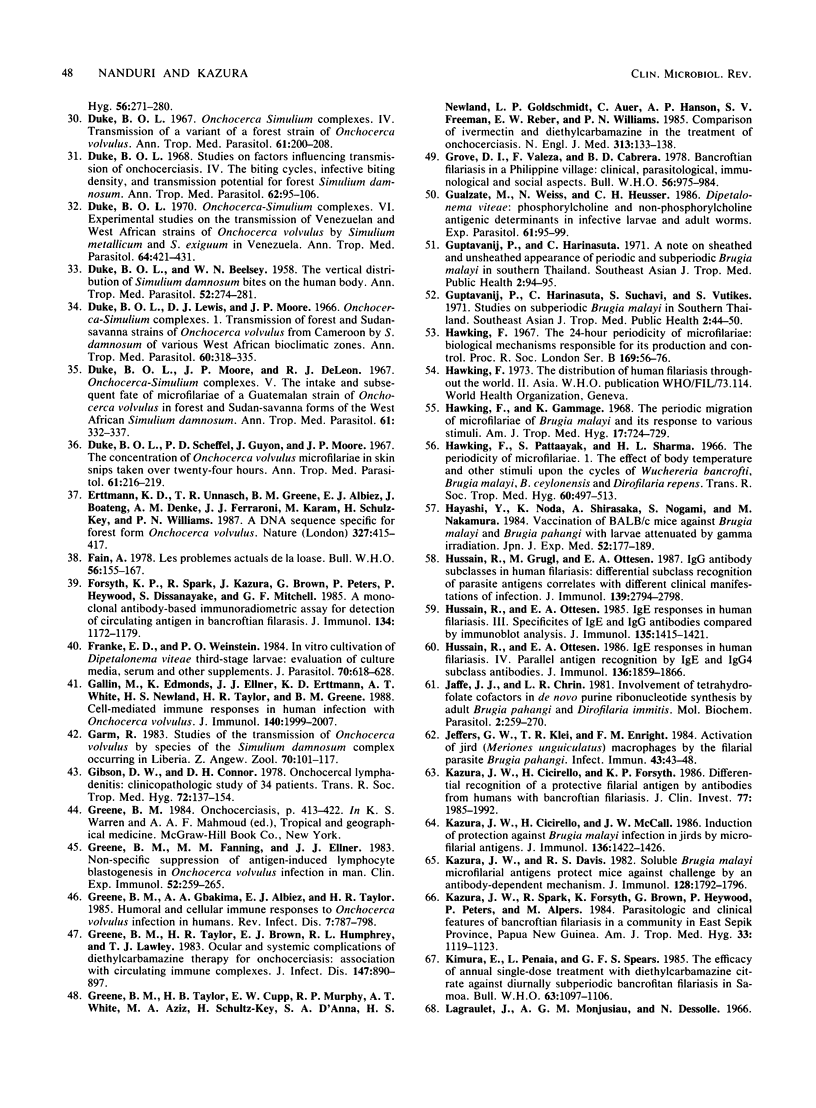
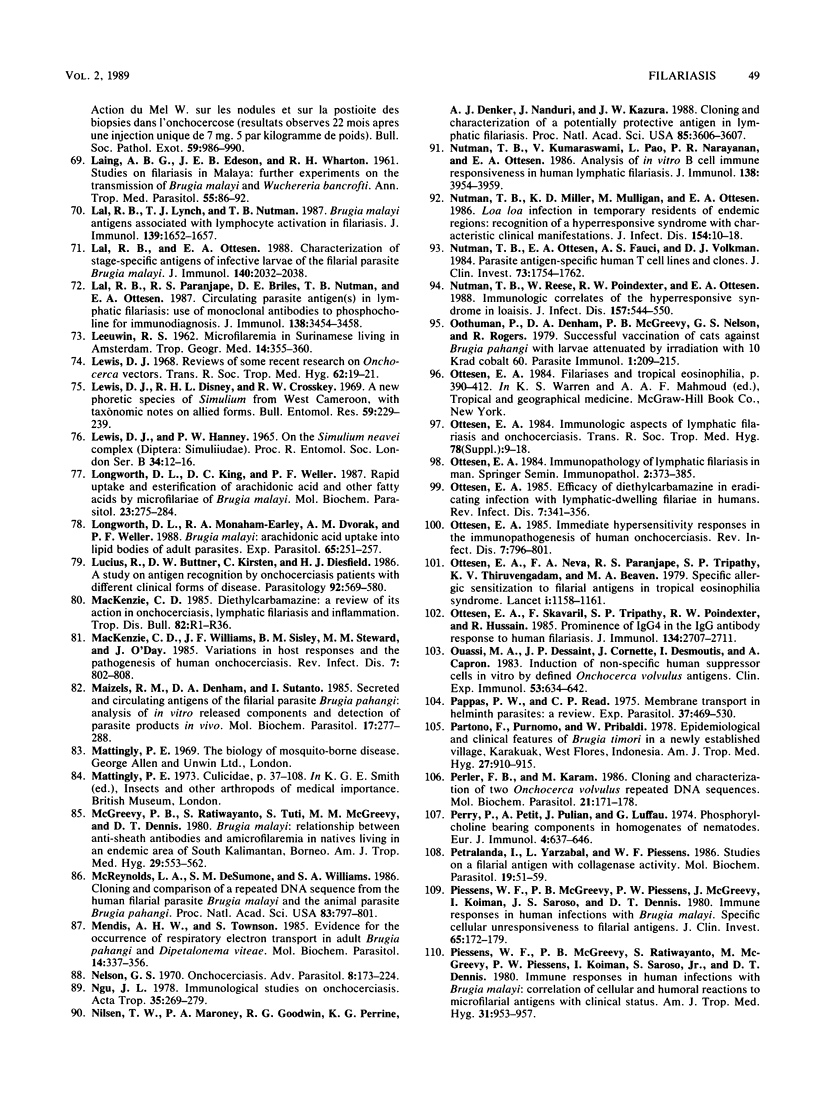
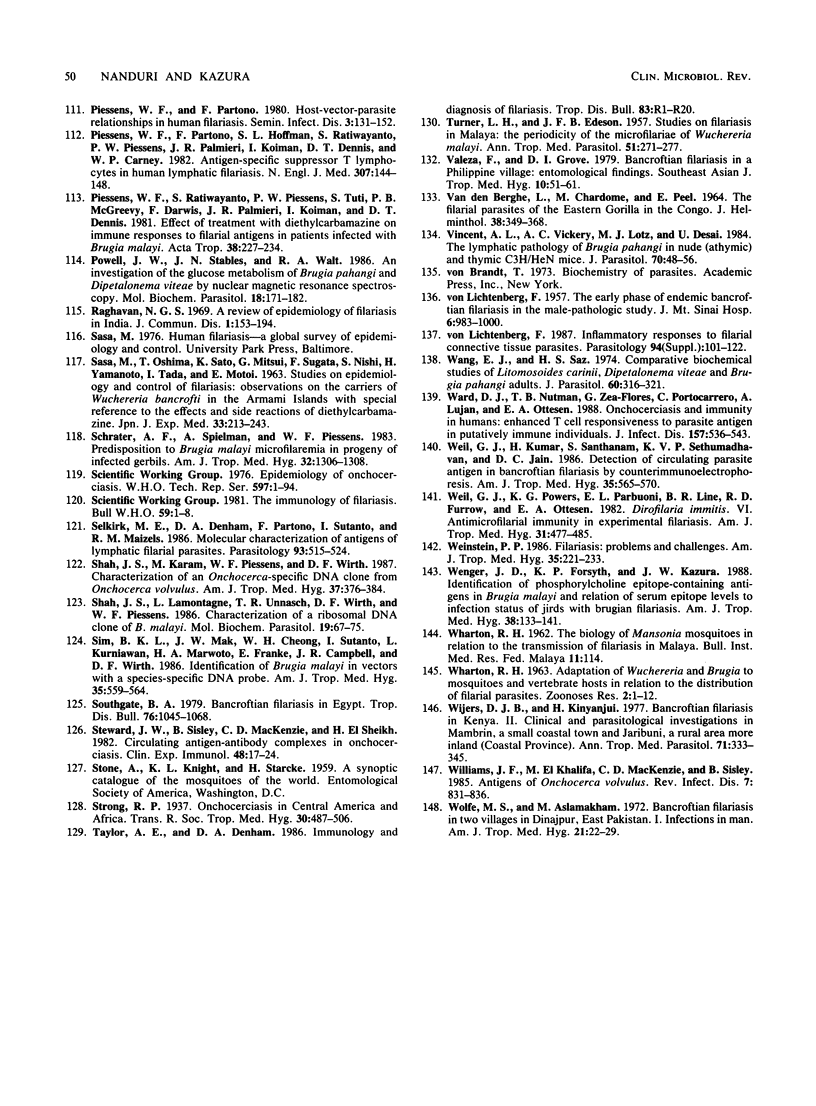
Selected References
These references are in PubMed. This may not be the complete list of references from this article.
- Anderson J., Fuglsang H., Hamilton P. J., de Marshall T. F. Studies on onchocerciasis in the United Cameroon Republic. I. Comparison of populations with and without Onchocerca volvulus. Trans R Soc Trop Med Hyg. 1974;68(3):190–208. doi: 10.1016/0035-9203(74)90116-3. [DOI] [PubMed] [Google Scholar]
- Arasu P., Philipp M., Perler F. Brugia malayi: recombinant antigens expressed by genomic DNA clones. Exp Parasitol. 1987 Dec;64(3):281–291. doi: 10.1016/0014-4894(87)90038-5. [DOI] [PubMed] [Google Scholar]
- Aziz M. A., Diallo S., Diop I. M., Lariviere M., Porta M. Efficacy and tolerance of ivermectin in human onchocerciasis. Lancet. 1982 Jul 24;2(8291):171–173. doi: 10.1016/s0140-6736(82)91026-1. [DOI] [PubMed] [Google Scholar]
- Bryan J. H., Southgate B. A. Some observations on filariasis in Western Samoa after mass administration of diethylcarbamazine. Trans R Soc Trop Med Hyg. 1976;70(1):39–48. doi: 10.1016/0035-9203(76)90005-5. [DOI] [PubMed] [Google Scholar]
- Buck A. A., Anderson R. I., Kawata K., Hitchcock J. C., Jr Onchocerciasis: some new epidemiologic and clinical findings. Results of an epidemiologic study in the Republic of Chad. Am J Trop Med Hyg. 1969 Mar;18(2):217–230. doi: 10.4269/ajtmh.1969.18.217. [DOI] [PubMed] [Google Scholar]
- Burren C. H. The behaviour of Brugia malayi microfilariae in experimentally infected domestic cats. Ann Trop Med Parasitol. 1972 Jun;66(2):235–242. doi: 10.1080/00034983.1972.11686821. [DOI] [PubMed] [Google Scholar]
- Canlas M. M., Piessens W. F. Stage-specific and common antigens of Brugia malayi identified with monoclonal antibodies. J Immunol. 1984 Jun;132(6):3138–3141. [PubMed] [Google Scholar]
- Canlas M., Wadee A., Lamontagne L., Piessens W. F. A monoclonal antibody to surface antigens on microfilariae of Brugia malayi reduces microfilaremia in infected jirds. Am J Trop Med Hyg. 1984 May;33(3):420–424. doi: 10.4269/ajtmh.1984.33.420. [DOI] [PubMed] [Google Scholar]
- Chen S. N., Howells R. E. The uptake in vitro of dyes, monosaccharides and amino acids by the filarial worm Brugia pahangi. Parasitology. 1979 Jun;78(3):343–354. doi: 10.1017/s0031182000051209. [DOI] [PubMed] [Google Scholar]
- Ciferri F. E., Kessel J. F. Relation of age, sex, and microfilaria density to treatment of sub-periodic filariasis with diethylcarbamazine. Am J Trop Med Hyg. 1967 May;16(3):321–328. doi: 10.4269/ajtmh.1967.16.321. [DOI] [PubMed] [Google Scholar]
- Comley J. C., Jaffe J. J. Retinol and filarial glycoprotein synthesis. Trans R Soc Trop Med Hyg. 1983;77(1):136–136. doi: 10.1016/0035-9203(83)90039-1. [DOI] [PubMed] [Google Scholar]
- Connor D. H., George G. H., Gibson D. W. Pathologic changes of human onchocerciasis: implications for future research. Rev Infect Dis. 1985 Nov-Dec;7(6):809–819. doi: 10.1093/clinids/7.6.809. [DOI] [PubMed] [Google Scholar]
- Connor D. H. Onchocerciasis. N Engl J Med. 1978 Feb 16;298(7):379–381. doi: 10.1056/NEJM197802162980706. [DOI] [PubMed] [Google Scholar]
- Court J. P., Murgatroyd R. C., Livingstone D., Rahr E. Physicochemical characteristics of non-electrolytes and their uptake by Brugia pahangi and Dipetalonema viteae. Mol Biochem Parasitol. 1988 Jan 15;27(2-3):101–108. doi: 10.1016/0166-6851(88)90029-1. [DOI] [PubMed] [Google Scholar]
- DUKE B. O., BEESLEY W. N. The vertical distribution of Simulium damnosum bites on the human body. Ann Trop Med Parasitol. 1958 Oct;52(3):274–281. doi: 10.1080/00034983.1958.11685868. [DOI] [PubMed] [Google Scholar]
- DUKE B. O. Studies on the biting habits of Chrysops. VII. The biting-cycles of nulliparous and parous C. silacea and C. dimidiata (bombe form). Ann Trop Med Parasitol. 1960 Jun;54:147–155. [PubMed] [Google Scholar]
- Denham D. A., McGreevy P. B. Brugian filariasis: epidemiological and experimental studies. Adv Parasitol. 1977;15:243–309. doi: 10.1016/s0065-308x(08)60530-8. [DOI] [PubMed] [Google Scholar]
- Dennis D. T., Partono F., Atmosoedjono P. S., Saroso J. S. Timor filariasis: epidemiologic and clinical features in a defined community. Am J Trop Med Hyg. 1976 Nov;25(6):797–802. doi: 10.4269/ajtmh.1976.25.797. [DOI] [PubMed] [Google Scholar]
- Desowitz R. S., Hitchcock J. C. Hyperendemic bancroftian filariasis in the Kingdom of Tonga: the application of the membrane filter concentration technique to an age-stratified blood survey. Am J Trop Med Hyg. 1974 Sep;23(5):877–879. doi: 10.4269/ajtmh.1974.23.877. [DOI] [PubMed] [Google Scholar]
- Diallo S., Aziz M. A., Ndir O., Badiane S., Bah I. B., Gaye O. Dose-ranging study of ivermectin in treatment of filariasis due to Wuchereria bancrofti. Lancet. 1987 May 2;1(8540):1030–1030. doi: 10.1016/s0140-6736(87)92291-4. [DOI] [PubMed] [Google Scholar]
- Disney R. H., Boreham P. F. Blood gorged resting blackflies in Cameroon and evidence of zoophily in Simulium damnosum. Trans R Soc Trop Med Hyg. 1969;63(2):286–287. doi: 10.1016/0035-9203(69)90163-1. [DOI] [PubMed] [Google Scholar]
- Dondero T. J., Jr, Bhattacharya N. C., Black H. R., Chowdhury A. B., Gubler D. J., Inui T. S., Mukerjee M. Clinical manifestations of Bancroftian filariasis in a suburb of Calcutta, India. Am J Trop Med Hyg. 1976 Jan;25(1):64–73. doi: 10.4269/ajtmh.1976.25.64. [DOI] [PubMed] [Google Scholar]
- Dondero T. J., Jr, Sivanandam S. Diurnally sub-periodic microfilarial pattern in Brugia malayi in West Malaysia. Trans R Soc Trop Med Hyg. 1971;65(5):691–693. doi: 10.1016/0035-9203(71)90067-8. [DOI] [PubMed] [Google Scholar]
- Duke B. O. Infective filaria larvae, other than Onchocerca volvulus, in Simulium damnosum. Ann Trop Med Parasitol. 1967 Jun;61(2):200–205. doi: 10.1080/00034983.1967.11686479. [DOI] [PubMed] [Google Scholar]
- Duke B. O., Lewis D. J., Moore P. J. Onchocerca-Simulium complexes. I. Transmission of forest and Sudan-savanna strains of Onchocerca volvulus, from Cameroon, by Simulium damnosum from various West African bioclimatic zones. Ann Trop Med Parasitol. 1966 Sep;60(3):318–326. [PubMed] [Google Scholar]
- Duke B. O., Moore P. J., De León J. R. Onchocerca-simulium complexes. V. The intake and subsequent fate of microfilariae of a Guatemalan strain of Onchocerca volvulus in forest and Sudan-savanna forms of West African Simulium damnosum. Ann Trop Med Parasitol. 1967 Sep;61(3):332–337. [PubMed] [Google Scholar]
- Duke B. O. Onchocerca-Simulium complexes. VI. Experimental studies on the transmission of Venezuelan and West African strains of Onchocerca volvulus by Simulium metallicum and S. exiguum in Venezuela. Ann Trop Med Parasitol. 1970 Dec;64(4):421–431. [PubMed] [Google Scholar]
- Duke B. O., Scheffel P. D., Guyon J., Moore P. J. The concentration of Onchocerca volvulus microfilariae in skin snips taken over twenty-four hours. Ann Trop Med Parasitol. 1967 Jun;61(2):206–219. doi: 10.1080/00034983.1967.11686480. [DOI] [PubMed] [Google Scholar]
- Duke B. O. Studies on factors influencing the transmisson of onchocerciasis. IV. The biting-cycles, infective biting density and transmission potential of "forest" Stimulium dannosum. Ann Trop Med Parasitol. 1968 Mar;62(1):95–106. doi: 10.1080/00034983.1968.11686535. [DOI] [PubMed] [Google Scholar]
- Erttmann K. D., Unnasch T. R., Greene B. M., Albiez E. J., Boateng J., Denke A. M., Ferraroni J. J., Karam M., Schulz-Key H., Williams P. N. A DNA sequence specific for forest form Onchocerca volvulus. Nature. 1987 Jun 4;327(6121):415–417. doi: 10.1038/327415a0. [DOI] [PubMed] [Google Scholar]
- Fain A. Les problèmes actuels de la loase. Bull World Health Organ. 1978;56(2):155–167. [PMC free article] [PubMed] [Google Scholar]
- Forsyth K. P., Spark R., Kazura J., Brown G. V., Peters P., Heywood P., Dissanayake S., Mitchell G. F. A monoclonal antibody-based immunoradiometric assay for detection of circulating antigen in Bancroftian filariasis. J Immunol. 1985 Feb;134(2):1172–1177. [PubMed] [Google Scholar]
- Franke E. D., Weinstein P. P. In vitro cultivation of Dipetalonema viteae third-stage larvae: evaluation of culture media, serum, and other supplements. J Parasitol. 1984 Oct;70(5):618–628. [PubMed] [Google Scholar]
- Gallin M., Edmonds K., Ellner J. J., Erttmann K. D., White A. T., Newland H. S., Taylor H. R., Greene B. M. Cell-mediated immune responses in human infection with Onchocerca volvulus. J Immunol. 1988 Mar 15;140(6):1999–2007. [PubMed] [Google Scholar]
- Gibson D. W., Connor D. H. Onchocercal lymphadenitis: Clinicopathologic study of 34 patients. Trans R Soc Trop Med Hyg. 1978;72(2):137–154. doi: 10.1016/0035-9203(78)90049-4. [DOI] [PubMed] [Google Scholar]
- Greene B. M., Fanning M. M., Ellner J. J. Non-specific suppression of antigen-induced lymphocyte blastogenesis in Onchocerca volvulus infection in man. Clin Exp Immunol. 1983 May;52(2):259–265. [PMC free article] [PubMed] [Google Scholar]
- Greene B. M., Taylor H. R., Brown E. J., Humphrey R. L., Lawley T. J. Ocular and systemic complications of diethylcarbamazine therapy for onchocerciasis: association with circulating immune complexes. J Infect Dis. 1983 May;147(5):890–897. doi: 10.1093/infdis/147.5.890. [DOI] [PubMed] [Google Scholar]
- Greene B. M., Taylor H. R., Cupp E. W., Murphy R. P., White A. T., Aziz M. A., Schulz-Key H., D'Anna S. A., Newland H. S., Goldschmidt L. P. Comparison of ivermectin and diethylcarbamazine in the treatment of onchocerciasis. N Engl J Med. 1985 Jul 18;313(3):133–138. doi: 10.1056/NEJM198507183130301. [DOI] [PubMed] [Google Scholar]
- Grove D. I., Valeza F. S., Cabrera B. D. Bancroftian filariasis in a Philippine village: clinical, parasitological, immunological, and social aspects. Bull World Health Organ. 1978;56(6):975–984. [PMC free article] [PubMed] [Google Scholar]
- Gualzata M., Weiss N., Heusser C. H. Dipetalonema viteae: phosphorylcholine and non-phosphorylcholine antigenic determinants in infective larvae and adult worms. Exp Parasitol. 1986 Feb;61(1):95–102. doi: 10.1016/0014-4894(86)90139-6. [DOI] [PubMed] [Google Scholar]
- Guptavanij P., Harinasuta C. A note on sheated and unsheathed appearance of periodic and sub-periodic Brugia Malayi in southern Thailand. Southeast Asian J Trop Med Public Health. 1971 Mar;2(1):94–95. [PubMed] [Google Scholar]
- Guptavanij P., Harinasuta C., Sucharit S., Vutikes S. Studies on sub-periodic Brugia malayi in southern Thailand. Southeast Asian J Trop Med Public Health. 1971 Mar;2(1):44–50. [PubMed] [Google Scholar]
- Hawking F., Gammage K. The periodic migration of microfilariae of Brugia malayi and its response to various stimuli. Am J Trop Med Hyg. 1968 Sep;17(5):724–729. doi: 10.4269/ajtmh.1968.17.724. [DOI] [PubMed] [Google Scholar]
- Hawking F., Pattanayak S., Sharma H. L. The periodicity of microfilariae. XI. The effect of body temperature and other stimuli upon the cycles of Wuchereria bancrofti, Brugia malayi, B. ceylonensis and Dirofilaria repens. Trans R Soc Trop Med Hyg. 1966;60(4):497–513. doi: 10.1016/0035-9203(66)90275-6. [DOI] [PubMed] [Google Scholar]
- Hayashi Y., Noda K., Shirasaka A., Nogami S., Nakamura M. Vaccination of BALB/c mice against Brugia malayi and B. pahangi with larvae attenuated by gamma irradiation. Jpn J Exp Med. 1984 Aug;54(4):177–181. [PubMed] [Google Scholar]
- Hussain R., Grögl M., Ottesen E. A. IgG antibody subclasses in human filariasis. Differential subclass recognition of parasite antigens correlates with different clinical manifestations of infection. J Immunol. 1987 Oct 15;139(8):2794–2798. [PubMed] [Google Scholar]
- Hussain R., Ottesen E. A. IgE responses in human filariasis. III. Specificities of IgE and IgG antibodies compared by immunoblot analysis. J Immunol. 1985 Aug;135(2):1415–1420. [PubMed] [Google Scholar]
- Hussain R., Ottesen E. A. IgE responses in human filariasis. IV. Parallel antigen recognition by IgE and IgG4 subclass antibodies. J Immunol. 1986 Mar 1;136(5):1859–1863. [PubMed] [Google Scholar]
- Jaffe J. J., Chrin L. R. Involvement of tetrahydrofolate cofactors in de novo purine ribonucleotide synthesis by adult Brugia pahangi and Dirofilaria immitis. Mol Biochem Parasitol. 1981 Apr;2(5-6):259–270. doi: 10.1016/0166-6851(81)90079-7. [DOI] [PubMed] [Google Scholar]
- Jeffers G. W., Klei T. R., Enright F. M. Activation of jird (Meriones unguiculatus) macrophages by the filarial parasite Brugia pahangi. Infect Immun. 1984 Jan;43(1):43–48. doi: 10.1128/iai.43.1.43-48.1984. [DOI] [PMC free article] [PubMed] [Google Scholar]
- Kazura J. W., Cicirello H., Forsyth K. Differential recognition of a protective filarial antigen by antibodies from humans with bancroftian filariasis. J Clin Invest. 1986 Jun;77(6):1985–1992. doi: 10.1172/JCI112527. [DOI] [PMC free article] [PubMed] [Google Scholar]
- Kazura J. W., Cicirello H., McCall J. W. Induction of protection against Brugia malayi infection in jirds by microfilarial antigens. J Immunol. 1986 Feb 15;136(4):1422–1426. [PubMed] [Google Scholar]
- Kazura J. W., Davis R. S. Soluble Brugia malayi microfilarial antigens protect mice against challenge by an antibody-dependent mechanism. J Immunol. 1982 Apr;128(4):1792–1796. [PubMed] [Google Scholar]
- Kazura J. W., Spark R., Forsyth K., Brown G., Heywood P., Peters P., Alpers M. Parasitologic and clinical features of bancroftian filariasis in a community in East Sepik Province, Papua New Guinea. Am J Trop Med Hyg. 1984 Nov;33(6):1119–1123. doi: 10.4269/ajtmh.1984.33.1119. [DOI] [PubMed] [Google Scholar]
- Kimura E., Penaia L., Spears G. F. The efficacy of annual single-dose treatment with diethylcarbamazine citrate against diurnally subperiodic bancroftian filariasis in Samoa. Bull World Health Organ. 1985;63(6):1097–1106. [PMC free article] [PubMed] [Google Scholar]
- LAING A. B., EDESON J. F., WHARTON R. H. Studies on filariasis in Malaya: further experiments on the transmission of Brugia malayi and Wuchereria bancrofti. Ann Trop Med Parasitol. 1961 Apr;55:86–92. doi: 10.1080/00034983.1961.11686022. [DOI] [PubMed] [Google Scholar]
- LEEUWIN R. S. Microfilaraemia in Surinamese living in Amsterdam. Trop Geogr Med. 1962 Dec;14:355–360. [PubMed] [Google Scholar]
- LICHTENBERG F. The early phase of endemic bancroftian filariasis in the male; pathological study. J Mt Sinai Hosp N Y. 1957 Nov-Dec;24(6):983–1000. [PubMed] [Google Scholar]
- Lagraulet J., Monjusiau A., Dessolle N. Action du Mel W sur les nodules et sur la positivité des biopsies dans l'onchocercose. (Résultats observés 22 mois après une injection unique de 7 mg. 5 par kilogramme de poids) Bull Soc Pathol Exot Filiales. 1966 Nov-Dec;59(6):984–990. [PubMed] [Google Scholar]
- Lal R. B., Lynch T. J., Nutman T. B. Brugia malayi antigens associated with lymphocyte activation in filariasis. J Immunol. 1987 Sep 1;139(5):1652–1657. [PubMed] [Google Scholar]
- Lal R. B., Ottesen E. A. Characterization of stage-specific antigens of infective larvae of the filarial parasite Brugia malayi. J Immunol. 1988 Mar 15;140(6):2032–2038. [PubMed] [Google Scholar]
- Lal R. B., Paranjape R. S., Briles D. E., Nutman T. B., Ottesen E. A. Circulating parasite antigen(s) in lymphatic filariasis: use of monoclonal antibodies to phosphocholine for immunodiagnosis. J Immunol. 1987 May 15;138(10):3454–3460. [PubMed] [Google Scholar]
- Lewis D. J. Review of some recent research on Onchocerca vectors. Trans R Soc Trop Med Hyg. 1968;62(1):19–21. doi: 10.1016/0035-9203(68)90025-4. [DOI] [PubMed] [Google Scholar]
- Longworth D. L., King D. C., Weller P. F. Rapid uptake and esterification of arachidonic acid and other fatty acids by microfilariae of Brugia malayi. Mol Biochem Parasitol. 1987 Apr;23(3):275–284. doi: 10.1016/0166-6851(87)90034-x. [DOI] [PubMed] [Google Scholar]
- Longworth D. L., Monahan-Earley R. A., Dvorak A. M., Weller P. F. Brugia malayi: arachidonic acid uptake into lipid bodies of adult parasites. Exp Parasitol. 1988 Apr;65(2):251–257. doi: 10.1016/0014-4894(88)90129-4. [DOI] [PubMed] [Google Scholar]
- Lucius R., Büttner D. W., Kirsten C., Diesfeld H. J. A study on antigen recognition by onchocerciasis patients with different clinical forms of disease. Parasitology. 1986 Jun;92(Pt 3):569–580. doi: 10.1017/s0031182000065458. [DOI] [PubMed] [Google Scholar]
- Mackenzie C. D., Williams J. F., Sisley B. M., Steward M. W., O'Day J. Variations in host responses and the pathogenesis of human onchocerciasis. Rev Infect Dis. 1985 Nov-Dec;7(6):802–808. doi: 10.1093/clinids/7.6.802. [DOI] [PubMed] [Google Scholar]
- Maizels R. M., Denham D. A., Sutanto I. Secreted and circulating antigens of the filarial parasite Brugia pahangi: analysis of in vitro released components and detection of parasite products in vivo. Mol Biochem Parasitol. 1985 Dec;17(3):277–288. doi: 10.1016/0166-6851(85)90002-7. [DOI] [PubMed] [Google Scholar]
- McGreevy P. B., Ratiwayanto S., Tuti S., McGreevy M. M., Dennis D. T. Brugia malayi: relationship between anti-sheath antibodies and amicrofilaremia in natives living in an endemic area of South Kalimantan, Borneo. Am J Trop Med Hyg. 1980 Jul;29(4):553–562. doi: 10.4269/ajtmh.1980.29.553. [DOI] [PubMed] [Google Scholar]
- McLaren D. J., Ortega-Pierres G., Parkhouse R. M. Trichinella spiralis: immunocytochemical localization of surface and intracellular antigens using monoclonal antibody probes. Parasitology. 1987 Feb;94(Pt 1):101–114. doi: 10.1017/s003118200005349x. [DOI] [PubMed] [Google Scholar]
- McReynolds L. A., DeSimone S. M., Williams S. A. Cloning and comparison of repeated DNA sequences from the human filarial parasite Brugia malayi and the animal parasite Brugia pahangi. Proc Natl Acad Sci U S A. 1986 Feb;83(3):797–801. doi: 10.1073/pnas.83.3.797. [DOI] [PMC free article] [PubMed] [Google Scholar]
- Mendis A. H., Townson S. Evidence for the occurrence of respiratory electron transport in adult Brugia pahangi and Dipetalonema viteae. Mol Biochem Parasitol. 1985 Mar;14(3):337–354. doi: 10.1016/0166-6851(85)90061-1. [DOI] [PubMed] [Google Scholar]
- Nelson G. S. Onchocerciasis. Adv Parasitol. 1970;8:173–224. doi: 10.1016/s0065-308x(08)60254-7. [DOI] [PubMed] [Google Scholar]
- Ngu J. L. Immunological studies on onchocerciasis. Varying skin hypersensitivity and leucocyte migration inhibition in a clinical spectrum of the disease. Acta Trop. 1978 Sep;35(3):269–279. [PubMed] [Google Scholar]
- Nilsen T. W., Maroney P. A., Goodwin R. G., Perrine K. G., Denker J. A., Nanduri J., Kazura J. W. Cloning and characterization of a potentially protective antigen in lymphatic filariasis. Proc Natl Acad Sci U S A. 1988 May;85(10):3604–3607. doi: 10.1073/pnas.85.10.3604. [DOI] [PMC free article] [PubMed] [Google Scholar]
- Nutman T. B., Kumaraswami V., Pao L., Narayanan P. R., Ottesen E. A. An analysis of in vitro B cell immune responsiveness in human lymphatic filariasis. J Immunol. 1987 Jun 1;138(11):3954–3959. [PubMed] [Google Scholar]
- Nutman T. B., Miller K. D., Mulligan M., Ottesen E. A. Loa loa infection in temporary residents of endemic regions: recognition of a hyperresponsive syndrome with characteristic clinical manifestations. J Infect Dis. 1986 Jul;154(1):10–18. doi: 10.1093/infdis/154.1.10. [DOI] [PubMed] [Google Scholar]
- Nutman T. B., Ottesen E. A., Fauci A. S., Volkman D. J. Parasite antigen-specific human T cell lines and clones. Major histocompatibility complex restriction and B cell helper function. J Clin Invest. 1984 Jun;73(6):1754–1762. doi: 10.1172/JCI111384. [DOI] [PMC free article] [PubMed] [Google Scholar]
- Nutman T. B., Reese W., Poindexter R. W., Ottesen E. A. Immunologic correlates of the hyperresponsive syndrome of loiasis. J Infect Dis. 1988 Mar;157(3):544–550. doi: 10.1093/infdis/157.3.544. [DOI] [PubMed] [Google Scholar]
- Oothuman P., Denham D. A., McGreevy P. B., Nelson G. S., Rogers R. Successful vaccination of cats against Brugia pahangi with larvae attenuated by irradiation with 10 krad cobalt 60. Parasite Immunol. 1979 Autumn;1(3):209–216. doi: 10.1111/j.1365-3024.1979.tb00707.x. [DOI] [PubMed] [Google Scholar]
- Ottesen E. A. Efficacy of diethylcarbamazine in eradicating infection with lymphatic-dwelling filariae in humans. Rev Infect Dis. 1985 May-Jun;7(3):341–356. doi: 10.1093/clinids/7.3.341. [DOI] [PubMed] [Google Scholar]
- Ottesen E. A. Immediate hypersensitivity responses in the immunopathogenesis of human onchocerciasis. Rev Infect Dis. 1985 Nov-Dec;7(6):796–801. doi: 10.1093/clinids/7.6.796. [DOI] [PubMed] [Google Scholar]
- Ottesen E. A. Immunological aspects of lymphatic filariasis and onchocerciasis in man. Trans R Soc Trop Med Hyg. 1984;78 (Suppl):9–18. doi: 10.1016/0035-9203(84)90309-2. [DOI] [PubMed] [Google Scholar]
- Ottesen E. A., Neva F. A., Paranjape R. S., Tripathy S. P., Thiruvengadam K. V., Beaven M. A. Specific allergic sensitsation to filarial antigens in tropical eosinophilia syndrome. Lancet. 1979 Jun 2;1(8127):1158–1161. doi: 10.1016/s0140-6736(79)91842-7. [DOI] [PubMed] [Google Scholar]
- Ottesen E. A., Skvaril F., Tripathy S. P., Poindexter R. W., Hussain R. Prominence of IgG4 in the IgG antibody response to human filariasis. J Immunol. 1985 Apr;134(4):2707–2712. [PubMed] [Google Scholar]
- Ouaissi M. A., Dessaint J. P., Cornette J., Desmoutis I., Capron A. Induction of non-specific human suppressor cells in vitro by defined Onchocerca volvulus antigens. Clin Exp Immunol. 1983 Sep;53(3):634–644. [PMC free article] [PubMed] [Google Scholar]
- Pappas P. W. Membrane transport in helminth parasites: a review. Exp Parasitol. 1975 Jun;37(3):469–530. doi: 10.1016/0014-4894(75)90016-8. [DOI] [PubMed] [Google Scholar]
- Partono F., Pribadi P. W., Soewarta A. Epidemiological and clinical features of Brugia timori in a newly established village. Karakuak, West Flores, Indonesia. Am J Trop Med Hyg. 1978 Sep;27(5):910–915. doi: 10.4269/ajtmh.1978.27.910. [DOI] [PubMed] [Google Scholar]
- Perler F. B., Karam M. Cloning and characterization of two Onchocerca volvulus repeated DNA sequences. Mol Biochem Parasitol. 1986 Nov;21(2):171–178. doi: 10.1016/0166-6851(86)90020-4. [DOI] [PubMed] [Google Scholar]
- Petralanda I., Yarzabal L., Piessens W. F. Studies on a filarial antigen with collagenase activity. Mol Biochem Parasitol. 1986 Apr;19(1):51–59. doi: 10.1016/0166-6851(86)90065-4. [DOI] [PubMed] [Google Scholar]
- Piessens W. F., McGreevy P. B., Piessens P. W., McGreevy M., Koiman I., Saroso J. S., Dennis D. T. Immune responses in human infections with Brugia malayi: specific cellular unresponsiveness to filarial antigens. J Clin Invest. 1980 Jan;65(1):172–179. doi: 10.1172/JCI109648. [DOI] [PMC free article] [PubMed] [Google Scholar]
- Piessens W. F., Partono F., Hoffman S. L., Ratiwayanto S., Piessens P. W., Palmieri J. R., Koiman I., Dennis D. T., Carney W. P. Antigen-specific suppressor T lymphocytes in human lymphatic filariasis. N Engl J Med. 1982 Jul 15;307(3):144–148. doi: 10.1056/NEJM198207153070302. [DOI] [PubMed] [Google Scholar]
- Piessens W. F., Ratiwayanto S., Piessens P. W., Tuti S., McGreevy P. B., Darwis F., Palmieri J. R., Koiman I., Dennis D. T. Effect of treatment with diethylcarbamazine on immune responses to filarial antigens in patients infected with Brugia malayi. Acta Trop. 1981 Sep;38(3):227–234. [PubMed] [Google Scholar]
- Powell J. W., Stables J. N., Watt R. A. An investigation of the glucose metabolism of Brugia pahangi and Dipetalonema viteae by nuclear magnetic resonance spectroscopy. Mol Biochem Parasitol. 1986 Feb;18(2):171–182. doi: 10.1016/0166-6851(86)90036-8. [DOI] [PubMed] [Google Scholar]
- Péry P., Petit A., Poulain J., Luffau G. Phosphorylcholine-bearing components in homogenates of nematodes. Eur J Immunol. 1974 Sep;4(9):637–639. doi: 10.1002/eji.1830040914. [DOI] [PubMed] [Google Scholar]
- Romeo De Leon J., Duke B. O. Experimental studies on the transmission of Guatemalan and West African strains of Onchocerca volvulus by Simulium ochraceum, S. metallicum and S. callidum. Trans R Soc Trop Med Hyg. 1966;60(6):735–752. doi: 10.1016/0035-9203(66)90223-9. [DOI] [PubMed] [Google Scholar]
- SASA M., OSHIMA T., SATO K., MITSUI G., SUGATA F., NISHI S., YAMAMOTO H., TADA I., MOTOI E. STUDIES ON EPIDEMIOLOGY AND CONTROL OF FILARIASIS: OBSERVATIONS ON THE CARRIERS OF WUCHERERIA BANCROFTI IN THE AMAMI ISLANDS WITH SPECIAL REFERENCE TO THE EFFECTS AND SIDE-REACTIONS OF DIETHYLCARBAMAZINE. Jpn J Exp Med. 1963 Aug;33:213–243. [PubMed] [Google Scholar]
- Schrater A. F., Spielman A., Piessens W. F. Predisposition to Brugia malayi microfilaremia in progeny of infected gerbils. Am J Trop Med Hyg. 1983 Nov;32(6):1306–1308. doi: 10.4269/ajtmh.1983.32.1306. [DOI] [PubMed] [Google Scholar]
- Shah J. S., Karam M., Piessens W. F., Wirth D. F. Characterization of an Onchocerca-specific DNA clone from Onchocerca volvulus. Am J Trop Med Hyg. 1987 Sep;37(2):376–384. doi: 10.4269/ajtmh.1987.37.376. [DOI] [PubMed] [Google Scholar]
- Shah J. S., Lamontagne L., Unnasch T. R., Wirth D. F., Piessens W. F. Characterization of a ribosomal DNA clone of Brugia malayi. Mol Biochem Parasitol. 1986 Apr;19(1):67–75. doi: 10.1016/0166-6851(86)90067-8. [DOI] [PubMed] [Google Scholar]
- Sim B. K., Mak J. W., Cheong W. H., Sutanto I., Kurniawan L., Marwoto H. A., Franke E., Campell J. R., Wirth D. F., Piessens W. F. Identification of Brugia malayi in vectors with a species-specific DNA probe. Am J Trop Med Hyg. 1986 May;35(3):559–564. doi: 10.4269/ajtmh.1986.35.559. [DOI] [PubMed] [Google Scholar]
- Southgate B. A. Bancroftian filariasis in Egypt. Trop Dis Bull. 1979 Dec;76(12):1045–1068. [PubMed] [Google Scholar]
- Steward M. W., Sisley B., Mackenzie C. D., El Sheikh H. Circulating antigen-antibody complexes in onchocerciasis. Clin Exp Immunol. 1982 Apr;48(1):17–24. [PMC free article] [PubMed] [Google Scholar]
- TURNER L. H., EDESON J. F. Studies on filariasis in Malaya: the periodicity of the microfilariae of Wuchereria malayi. Ann Trop Med Parasitol. 1957 Sep;51(3):271–277. doi: 10.1080/00034983.1957.11685816. [DOI] [PubMed] [Google Scholar]
- VANDENBERGHE L., CHARDOME M., PEEL E. THE FILARIAL PARASITES OF THE EASTERN GORILLA IN THE CONGO. J Helminthol. 1964;38:349–368. doi: 10.1017/s0022149x00033903. [DOI] [PubMed] [Google Scholar]
- Valeza F. S., Grove D. I. Bancroftian filariasis in a Philippine village: entomological findings. Southeast Asian J Trop Med Public Health. 1979 Mar;10(1):51–61. [PubMed] [Google Scholar]
- Vincent A. L., Vickery A. C., Lotz M. J., Desai U. The lymphatic pathology of Brugia pahangi in nude (athymic) and thymic mice C3H/HeN. J Parasitol. 1984 Feb;70(1):48–56. [PubMed] [Google Scholar]
- WHARTON R. H. Adaptation of Wuchereia and Brugia to mosquitoes and vertebrate hosts in relation to the distribution of filarial parasites. Zoonoses Res. 1963 Apr;2:1–12. [PubMed] [Google Scholar]
- WHARTON R. H. The biology of Mansonia mosquitoes in relation to the transmission of filariasis in Malaya. Bull Inst Med Res Kuala Lumpur. 1962;11:1–114. [PubMed] [Google Scholar]
- Wang E. J., Saz H. J. Comparative biochemical studies of Litomosoides carinii, Dipetalonema viteae, and Brugia pahangi adults. J Parasitol. 1974 Apr;60(2):316–321. [PubMed] [Google Scholar]
- Ward D. J., Nutman T. B., Zea-Flores G., Portocarrero C., Lujan A., Ottesen E. A. Onchocerciasis and immunity in humans: enhanced T cell responsiveness to parasite antigen in putatively immune individuals. J Infect Dis. 1988 Mar;157(3):536–543. doi: 10.1093/infdis/157.3.536. [DOI] [PubMed] [Google Scholar]
- Weil G. J., Kumar H., Santhanam S., Sethumadhavan K. V., Jain D. C. Detection of circulating parasite antigen in bancroftian filariasis by counterimmunoelectrophoresis. Am J Trop Med Hyg. 1986 May;35(3):565–570. doi: 10.4269/ajtmh.1986.35.565. [DOI] [PubMed] [Google Scholar]
- Weil G. J., Powers K. G., Parbuoni E. L., Line B. R., Furrow R. D., Ottesen E. A. Dirofilaria immitis. VI. Antimicrofilarial immunity in experimental filariasis. Am J Trop Med Hyg. 1982 May;31(3 Pt 1):477–485. [PubMed] [Google Scholar]
- Weinstein P. P. Filariasis: problems and challenges. Am J Trop Med Hyg. 1986 Mar;35(2):221–233. doi: 10.4269/ajtmh.1986.35.221. [DOI] [PubMed] [Google Scholar]
- Wenger J. D., Forsyth K. P., Kazura J. W. Identification of phosphorylcholine epitope-containing antigens in Brugia malayi and relation of serum epitope levels to infection status of jirds with brugian filariasis. Am J Trop Med Hyg. 1988 Jan;38(1):133–141. doi: 10.4269/ajtmh.1988.38.133. [DOI] [PubMed] [Google Scholar]
- Wijers D. J., Kinyanjui H. Bancroftian filariasis in Kenya II. Clinical and parasitological investigations in Mambrui, a small coastal town, and Jaribuni, a rural area more inland (Coast Province). Ann Trop Med Parasitol. 1977 Sep;71(3):333–345. [PubMed] [Google Scholar]
- Williams J. F., el Khalifa M., Mackenzie C. D., Sisley B. Antigens of Onchocerca volvulus. Rev Infect Dis. 1985 Nov-Dec;7(6):831–836. doi: 10.1093/clinids/7.6.831. [DOI] [PubMed] [Google Scholar]
- Wolfe M. S., Aslamkhan M. Bancroftian filiariasis in two villages in Dinajpur District, East Pakistan. I. Infections in man. Am J Trop Med Hyg. 1972 Jan;21(2):22–29. doi: 10.4269/ajtmh.1972.21.22. [DOI] [PubMed] [Google Scholar]


